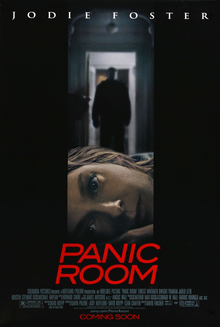Our website is made possible by displaying online advertisements to our visitors.
Please consider supporting us by disabling your ad blocker.
Panic Room
| Panic Room | |
|---|---|
 Theatrical release poster | |
| Directed by | David Fincher |
| Written by | David Koepp |
| Produced by |
|
| Starring | |
| Cinematography | |
| Edited by | |
| Music by | Howard Shore |
Production companies |
|
| Distributed by | Sony Pictures Releasing |
Release date |
|
Running time | 112 minutes[1] |
| Country | United States |
| Language | English |
| Budget | $48 million[1] |
| Box office | $197.1 million[1] |
Panic Room is a 2002 American thriller film directed by David Fincher. The film stars Jodie Foster and Kristen Stewart as a mother and daughter whose new home is invaded by burglars, played by Forest Whitaker, Jared Leto, and Dwight Yoakam. The script was written by David Koepp, whose screenplay was inspired by news coverage in 2000 about panic rooms.
The film was Fincher's fifth feature film, following Fight Club (1999). Fincher and Koepp brought together a crew of people with whom each had worked with before. The house and its panic room were built on a Raleigh Studios lot. Nicole Kidman was originally cast as the mother, but she left after aggravating a previous injury. Her departure threatened the completion of the film, but Foster quickly replaced Kidman. The filmmakers used computer-generated imagery to create the illusion of the film camera moving through the house's rooms. Foster became pregnant during the shooting schedule, so filming was suspended until after she gave birth. The film's production cost $48 million.
The film was commercially released in the United States and Canada on March 29, 2002. The film grossed $30 million on its opening weekend. In the United States and Canada, it grossed $96.4 million. In other territories, it grossed $100.7 million for a worldwide total of $197.1 million. The film was well-received by critics, who praised Foster's performance and the film's suspense. Panic Room has been analyzed for its exploration of gender and feminism, as well as its portrayal of surveillance technologies, diabetes, and mortality. The film has also been critiqued for its depictions of domesticity, race, real estate, ecological anxieties, and its thematic engagement with existential dread.
- ^ a b c "Panic Room". Box Office Mojo. IMDb. Archived from the original on January 17, 2021. Retrieved January 17, 2021.
Previous Page Next Page


